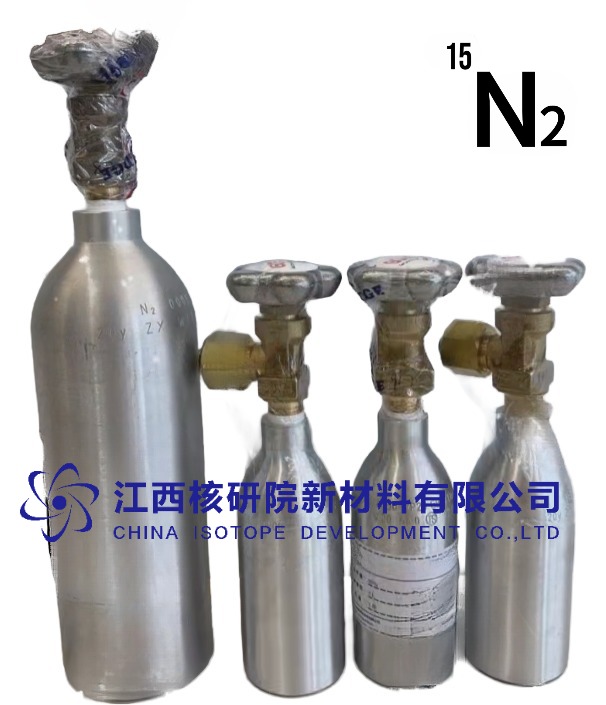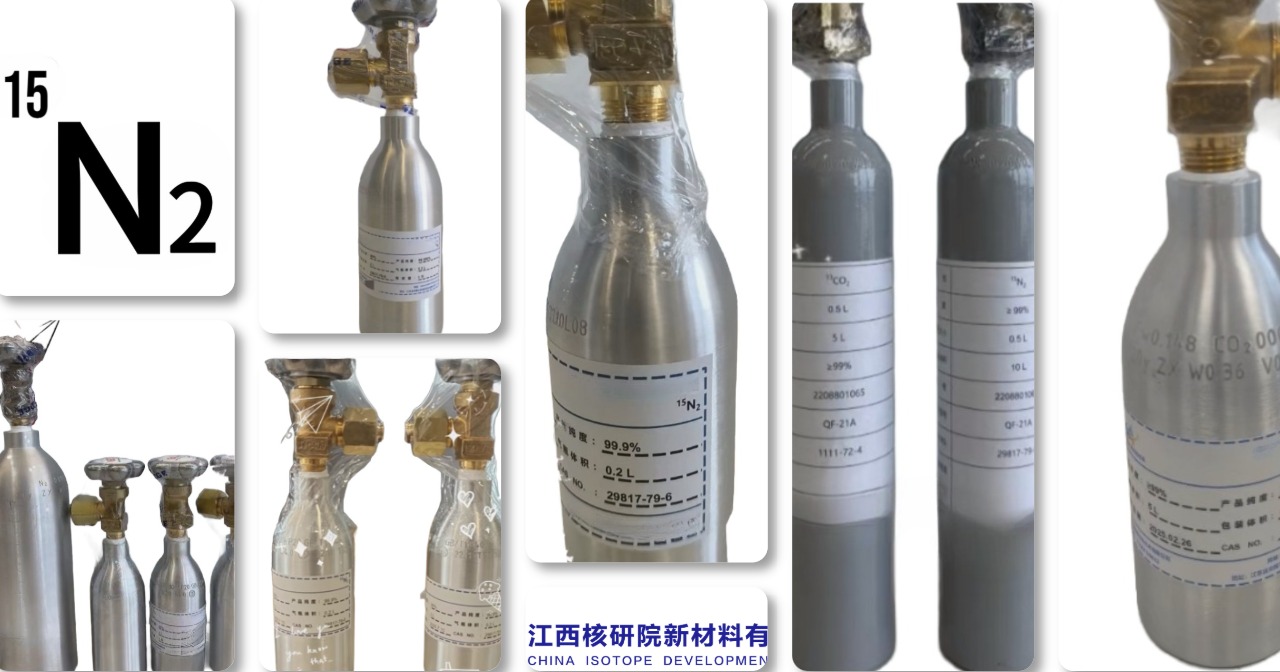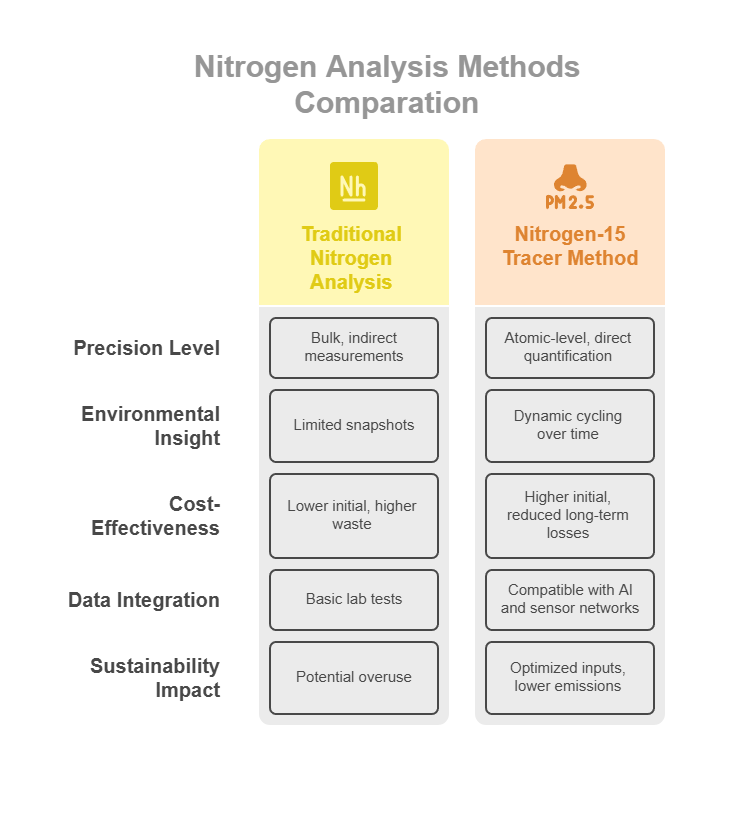Why Nitrogen-15 is Essential for Precision Soil Fertility Studies
BY Tao, Published Aug 13, 2025
As a veteran in nuclear research with over three decades immersed in the nuances of isotopes and elemental gases, I’ve seen how Nitrogen-15 revolutionizes our approach to soil management. This stable isotope, a rarer form of nitrogen, provides the precision needed to decode soil fertility dynamics at a molecular level. In an age where sustainable agriculture demands exactitude, Nitrogen-15 stands as a vital tool, enabling researchers and farmers to optimize nutrient use while minimizing environmental harm. Its applications in tracing nitrogen pathways underscore why it’s indispensable for advancing precision soil fertility studies.
Nitrogen-15’s unique properties allow for non-destructive monitoring of soil processes, offering insights that traditional methods simply can’t match. From my extensive work with gaseous and solid isotopes, I’ve observed how this element bridges the gap between laboratory analysis and field application, fostering data-driven strategies that enhance crop productivity and soil health.
1. Understanding Nitrogen-15: A Stable Isotope Primer
Nitrogen-15, symbolized as ¹⁵N, is one of the two stable isotopes of nitrogen, the other being the more common Nitrogen-14. Comprising seven protons and eight neutrons, it boasts a nuclear spin of 1/2, which makes it particularly amenable to advanced analytical techniques like nuclear magnetic resonance (NMR) and isotope ratio mass spectrometry (IRMS). Naturally occurring at a mere 0.366% abundance, Nitrogen-15 requires enrichment processes—such as chemical exchange or distillation—to reach usable concentrations for research.
In soil fertility contexts, Nitrogen-15 serves as an ideal tracer because it mimics the behavior of natural nitrogen without introducing radioactivity. This stability ensures that labeled compounds remain intact over extended periods, allowing for accurate tracking of nitrogen transformations in complex soil environments. Over the years, I’ve integrated Nitrogen-15 into studies examining microbial activity, where its distinct isotopic signature helps differentiate between various nitrogen sources, from atmospheric fixation to fertilizer inputs.
Key attributes that make Nitrogen-15 essential include:
- Atomic Composition: 7 protons, 8 neutrons, resulting in a mass of 15 atomic mass units.
- Enrichment Methods: Achieved through processes like the exchange between nitric acid and nitrogen oxides, yielding purities up to 99.9%.
- Detection Sensitivity: Compatible with IRMS, capable of detecting differences as small as 0.001% in isotopic ratios.
- Environmental Safety: Non-radioactive, posing no long-term ecological risks.
These features position Nitrogen-15 as a cornerstone for precision studies, where understanding soil nitrogen cycles is paramount.
2. The Critical Role of Nitrogen-15 in Soil Fertility Dynamics
Soil fertility hinges on nitrogen availability, a nutrient often limiting plant growth. Nitrogen-15 excels in elucidating these dynamics by enabling precise quantification of nitrogen use efficiency (NUE). In precision soil fertility studies, incorporating ¹⁵N-labeled fertilizers reveals how much applied nitrogen is absorbed by crops versus lost through leaching, volatilization, or denitrification—processes that contribute to greenhouse gas emissions and water pollution.
From my perspective, honed through countless field trials, Nitrogen-15’s tracer capability uncovers inefficiencies in conventional farming. For instance, it highlights how soil pH and organic matter influence nitrogen immobilization by microbes, guiding amendments to improve fertility. In variable-rate application systems, data from ¹⁵N studies inform zone-specific fertilization, reducing overuse in high-fertility areas and bolstering deficient zones.
Moreover, Nitrogen-15 aids in assessing biological nitrogen fixation (BNF) by legumes. By measuring the dilution of ¹⁵N in plant tissues against a labeled reference, researchers calculate fixed nitrogen amounts, optimizing crop rotations for sustainable fertility. This isotope’s role extends to evaluating cover crops’ contributions to soil nitrogen pools, promoting regenerative practices that enhance long-term soil health.
To encapsulate its impact, consider these core benefits in soil studies:
- Nitrogen Loss Mitigation: Tracks pathways to minimize environmental runoff.
- Microbial Interaction Insights: Reveals symbiotic relationships affecting fertility.
- Crop-Specific Optimization: Tailors nitrogen inputs for maximum yield with minimal waste.
Through such applications, Nitrogen-15 empowers precision agriculture, transforming soil fertility from guesswork to science.
3. Applications of Nitrogen-15 in Precision Agriculture
Precision agriculture relies on data granularity, and Nitrogen-15 delivers by facilitating site-specific soil fertility assessments. In variable soil landscapes, ¹⁵N-labeled probes map nitrogen hotspots, integrating with GIS and remote sensing for targeted interventions. My involvement in international projects has shown how this isotope supports decision-support systems, where real-time data from ¹⁵N experiments adjust fertilizer applications via automated machinery.
One standout application is in evaluating slow-release fertilizers. By comparing ¹⁵N recovery rates, studies demonstrate how coated urea reduces volatilization losses by up to 40%, preserving soil fertility amid fluctuating weather. Nitrogen-15 also plays a key role in climate-resilient farming, tracing how elevated CO₂ levels alter nitrogen cycling and advising on adaptive strategies.
In organic systems, Nitrogen-15 verifies the efficacy of green manures and composts. Isotopic signatures distinguish organic-derived nitrogen, ensuring compliance with certification standards and boosting consumer trust. For large-scale operations, ¹⁵N-based models predict fertility trends, aiding in resource allocation across vast acreages.
A comparative table highlights Nitrogen-15’s advantages over traditional methods:
Above illustration underscores why Nitrogen-15 is pivotal for modern, data-intensive soil fertility studies.
4. Nitrogen-15 Product Parameters and Performance
For researchers engaging in precision soil fertility studies, selecting the right Nitrogen-15 product is crucial. Available in various forms, these products are engineered for high performance in demanding applications.
Essential parameters include:
- Isotopic Purity: 95-99.9%, ensuring minimal dilution from Nitrogen-14 for accurate tracing.
- Chemical Variants: Offered as ammonium sulfate ((¹⁵NH₄)₂SO₄), potassium nitrate (K¹⁵NO₃), or gaseous N₂, catering to soil, plant, or atmospheric studies.
- Concentration Ranges: From 5 atom% for broad-field applications to 98 atom% for high-resolution lab work.
- Packaging: Sealed ampoules or cylinders, with volumes from 1 liter (gas) to 100 grams (solids).
- Shelf Life: Virtually unlimited due to stability, though recommended storage below 25°C in dry conditions.
Performance metrics shine in real-world use. In soil incubation experiments, Nitrogen-15 achieves detection sensitivities down to 0.01‰ δ¹⁵N, outperforming unlabeled techniques by providing quantifiable flux rates. Recovery efficiencies in crop trials often exceed 60% with optimized formulations, compared to 30-50% for standard fertilizers. Its compatibility with analytical instruments like continuous-flow IRMS ensures rapid, high-throughput analysis, with turnaround times under 24 hours for sample batches.
In performance testing, Nitrogen-15-labeled compounds exhibit low volatility in acidic soils, maintaining label integrity for months. This reliability supports longitudinal studies, where repeated sampling tracks seasonal fertility shifts without recalibration.

Nitrogen-15
5. Best Practices for Using Nitrogen-15 in Soil Studies
To harness Nitrogen-15 effectively, adhere to protocols that maximize its utility while ensuring safety. Begin by calibrating application rates: For field plots, apply ¹⁵N at 10-20 kg/ha equivalent, diluted to match natural abundances for realistic simulations.
Usage considerations:
- Application Techniques: Incorporate into soil via banding or foliar sprays; avoid broadcast in windy conditions to prevent label loss.
- Sampling Protocols: Collect soil cores at depths of 0-30 cm post-application, analyzing via IRMS for δ¹⁵N values.
- Data Interpretation: Use mass balance equations to compute NUE, factoring in background isotopic ratios.
- Integration with Tech: Combine with drone imagery for spatial mapping of ¹⁵N distribution.
Safety is straightforward given its non-radioactive nature, but handle with care: Use gloves when mixing solutions to avoid skin contact, and ensure adequate ventilation for gaseous forms to prevent oxygen displacement. Store in inert atmospheres to preserve purity, and dispose of residues as non-hazardous waste per environmental guidelines. In my experience, meticulous handling prevents cross-contamination, yielding pristine data sets.
6. Emerging Trends and Future Directions
The horizon for Nitrogen-15 in precision soil fertility studies is expansive. Advances in nanotechnology promise ¹⁵N-encapsulated fertilizers for controlled release, further elevating NUE in challenging soils. Coupling with machine learning, predictive models based on ¹⁵N data could forecast fertility under climate scenarios, aiding global food security.
In developing regions, affordable ¹⁵N kits could democratize access, empowering smallholders with precision tools. As isotope enrichment costs decline, widespread adoption seems imminent, potentially reducing global nitrogen fertilizer use by 20-30% through informed practices.
Nitrogen-15’s essence lies in its ability to illuminate the invisible intricacies of soil fertility, driving sustainable agriculture forward with unmatched precision.
Would you like a deeper dive into any specific applications (e.g., cancer diagnostics, microbiome research)?
(Follow our update on www.asiaisotopeintl.com or contact tao.hu@asiaisotope.com for more information or call us for a in-time communications.)








